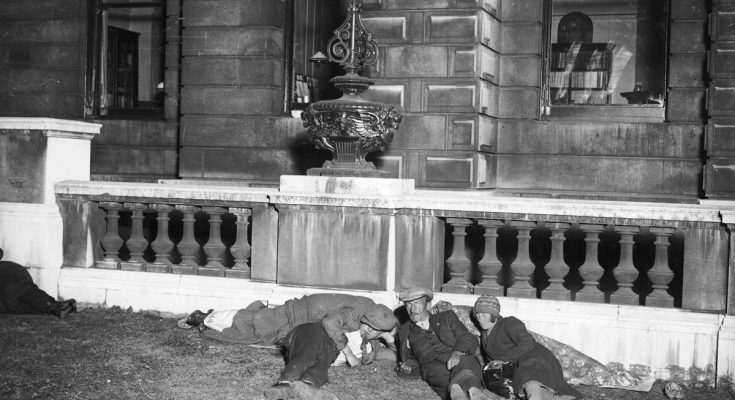‘Back to the Thirties’ by Charles Webster (previously Director, Wellcome Unit for the History of Medicine, University of Oxford).
First published in September 1984 in the public health journal Radical Community Medicine, this essay reflects many of the issues the NHS and public health face today, from the PR management of statistics and altering of history to the refusal of government to acknowledge the need to spend to alleviate poverty. We are grateful to Alex Scott-Samuel, editor and publisher of the journal, for his kind permission to re-print this essay.
A multiplicity of ways are being used to undermine public confidence in the National Health Service. Among other things history is being rewritten to cast doubt on the record of the Welfare State. It is now common to find the Welfare State portrayed as a destructive force ‘expanding at an explosive rate’ or as the ‘time bomb ticking under us all’ (Daily Mail 24.1.84). By contrast, in appealing for the revival of Victorian values, it is implied that welfare was handled better under the voluntary system. Social scientists and historians have obligingly come forward to suggest that stories of adverse social effects of the slump have been magnified. The inter-war period is portrayed as a phase of expansion, of new industry and of general increase in living standards. By contrast, the welfare state is described as a ‘cult of superstition’, a myth to be destroyed by the economic realists. We are thus from many different quarters temptingly invited to turn the clock back to the Thirties.
But history is not so obliging a servant of the establishment. To any critical observer it is clear that the NHS was not created out of a gratuitous desire to extend state intervention. Quite the reverse: the NHS was the unavoidable consequence of World War 2. At the outset of hostilities it was realised that effective defence necessitated complete recasting of the medical services. Once this Emergency Medical Service was in operation it was realised that it would be impossible to revert to the previous system by dismantling what was in effect a prototype NHS. The force of this argument was appreciated by all political parties and by all sections of the medical profession. To this extent the NHS was supported by an almost universal consensus and that consensus has remained intact until the recent commencement of crude attacks upon the Welfare State.
The need to form the Emergency Medical Service and then the NHS thus arose from the unsatisfactory state of the health services in interwar Britain. Because the dismal record of these services is now tending to be overlooked it is useful to recall just how inadequate was the state of healthcare before World War 2.
Paradoxically, one of the striking indications of the inadequacy of Britain’s health record comes from the excessive tone of optimism adopted in official reports, especially the influential Annual Reports of Medical Officers of Health at the local level. These reports tell a story of continuous improvement on almost all fronts. Collectively they convey an impression that problems of ill-health were being contained to such an extent that they had reached an almost irreducible minimum by the Thirties. These records bear comparison with Stalinist excess in statistical falsification and in retrospect it is clear how epidemiological data was used as a political weapon to justify low rates of unemployment relief and as a buttress to the policies of retrenchment of the National government.
Inevitably the above complacency produced a severe backlash. For instance, the MOH for Stockton-on-Tees G C M M’Gonigle and his sanitary inspector published Poverty and Public Health (1936) giving an almost diametrically opposite impression of health in the depressed towns from that contained in official reports. The impact of M’Gonigle’s work was reinforced by the inclusion of a preface written by the great biochemist, Frederick Gowland Hopkins, who was at the time President of the Royal Society. Gradually the rosy edifice of official health statistics crumbled away and it became apparent that minor improvements in indices relating to life expectancy and infant mortality was insufficient to disguise the nation’s inadequate health record.
Among the major grounds for concern were:
- By 1939 England and Wales had slipped to ninth position in the League of Nations’ Table of Infant Mortality. Scotland by then was 17th. This was merely one indication that Britain was falling behind its Dominions and other major western nations in its health record.
- Striking regional, class and occupational disparities were evident across the broad front of mortality and morbidity statistics. Scotland and Northern Ireland were comparable with the worst regions of England and Wales, which tended to be South Wales and the North West.
- The pattern within any region was complex with regard to its distribution of blackspots. For instance, taking the industrial towns of the North West in 1930, the best wards had an Infant Mortality Rate of below 40 whereas in the worst wards the IMR was above 150. Similarly, in better areas the Maternal Mortality Rate was about 2 whereas in ‘problem areas’ it was commonly above 10.
- As Titmuss was the first to demonstrate in 1938, there was every sign that differentials between the social classes were persisting, despite the claim that welfare benefits had largely solved the problem. Using methods recently revived for the purposes of the Black Report, Titmuss demonstrated that there was commonly a 500% differential between social classes I and IV. The differential among infants increased rapidly after the first month of life.
- Maternal mortality had increased dramatically during the interwar period to reach a peak in 1934. Levels of maternal disablement were so great that formal investigation into this problem was blocked by the Ministry of Health. However, officials confidentially admitted that estimates of some 50,000 cases of maternal disablement occurring annually were likely to be correct.
- Among the major causes of maternal mortality and morbidity, it became increasingly clear that a) the low health status of the mother and b) incompetent medical intervention, were of primary importance. Thus, in South Wales, Lady Rhys Williams claimed to achieve a reduction in maternal mortality from 6.39 to 1.64 solely by means of supplementary feeding of mothers. In a representative study by a leading gynaecologist, Aleck Bourne, it was estimated that of 1,917 cases of death, more than half might have been saved if ‘the full resources of knowledge both of prevention and treatment could have been utilised’.
- On the basis of the first elaborate nutritional surveys to be undertaken in Britain, Sir John Boyd Orr drew the alarming conclusion that a substantial section of the population was malnourished. Evidence from a variety of sources suggested that up to one half of the child population was malnourished to some degree. On the basis of budgetary surveys it was clear that malnutrition was likely to be endemic among the families of the 1.5 – 3 million unemployed, as well as among a large population of low wage earners, numbering at least 2 million according to Kuczynski.
- The large section of the population living in overcrowded or insanitary accommodation was exposed to much higher rates of infectious disease, tuberculosis, bronchial diseases, infestation etc. Once again, levels of overcrowding and slum dwelling were so high that the Ministry of Health adopted standards disguising the seriousness of the problem. Even according to the unrealistic standards adopted by the Ministry, industrial towns commonly showed 20% overcrowding, whilst in Clydesdale this estimate reached 45%.
- The above conditions contributed to high levels of debility among working class schoolchildren, which was to some extent reflected in height/weight measurements but even more in levels of rickets, bronchial conditions, rheumatic heart disease, infestation, etc. Prior to World war 2 4,000 child lives were unnecessarily lost each year owing to non-implementation of diphtheria immunisation.
The above catalogue of mortality and debility is by no means exhaustive. Shocked by official complacency concerning these facts, experts such as Titmuss were stung into expressions of deep indignation. ‘The high maternal mortality, the excessive mortality among infants, children and young people, the severe incidence of nutritional defects and tuberculosis among young people, and of deaths from heart disease in the Thirties, the premature ageing and the defect-shortened lives and all the amassed evidential statistics from many and varied sources (shows) that we are losing one quarter of our population every generation, and faced with the fact that that at least 500,000 excess deaths have occurred in the North and Wales during the last ten years can only point…to the presence of intense poverty on a scale so considerable and so widespread…’
Many of the above problems had their roots in poverty, unemployment, low income and environmental degradation. Incompetence of the health service was superimposed on these threats to life. The inefficiency and inadequacy of the interwar health services resulted from the haphazard way in which the structure had developed. By 1939 the British healthcare system had achieved labyrinthine complexity, but it was still deficient in many respects.
The reputation of this system rested on the much acclaimed ’glory’ of the voluntary hospitals. To be more precise, the genuine reputation derived from the teaching hospitals, whereas the great majority of the 1000 voluntary hospitals were inconveniently small, overcrowded, impoverished and obsolete. The system of honorary medical appointments was breaking down, while the nursing staff were tiring of exploitation. By the outbreak of war the charitable basis of funding had collapsed and the system as a whole was bankrupt. Although new sources of income had been developed, these were insufficient to keep up with rising costs. By 1940 10 of the 28 teaching hospitals were in deficit. In London, voluntary contributions, which were the traditional source of income, were accounting for only 30% of the voluntary hospital income. Payments from patients were now accounting for a further 30% of that income. In other words the principle of free treatment had been sacrificed. Patients were thus faced with a choice between contributory schemes and means-tested payments.
Of the remaining element in voluntary hospital income, a substantial amount was derived from fees for services paid by local authorities. The war further precipitated reliance on public funds. Consequently by 1945 the voluntary system was voluntary in name only.
The inadequacy of the voluntary hospital system prompted local authorities in many areas to extend into the acute hospital sector. By 1939 the voluntary system and the local authorities were contributing equally to the 140,000 acute beds. Because the local authorities were already providing chronic, mental and mental deficiency hospital care, they now became the dominant partner in the hospital field. By 1939 certain local authorities were providing virtually comprehensive hospital services, which were better coordinated and more adequately financed than the voluntary system. But local authority hospitals were themselves variable in quality, often marred by the taint of the poor law and providing a low grade of service. Only gradually were staff being recruited capable of matching the quality of the honorary medical staff of the teaching hospitals.
Hospitals were merely one part of the expanding constellation of local authority services. Perhaps the most important addition in the ‘30s was the midwifery service. Although in theory local authorities were providing a virtually comprehensive system of clinics for mothers, infants and children, provision of these services was usually not mandatory, while their performance was not as good as the bureaucrats supposed from superficial statistics. There was thus enormous variation in quantity and quality of provision of such services as maternity units, specialist treatment, dental services, nursery schools, or supplementary nutrition for mothers and children. By 1939 25% of deliveries were occurring in hospital; in some districts more than half the deliveries were taking place in maternity units, while in others this facility was vitually absent. Although the school meals service had existed for 30 years by 1939 it was only providing free meals for 2% of the school population. By 1939 only a few towns had immunised more than half of their children against diphtheria, while the level in London was only 6%. Such statistics suggest that for the majority of the population local authority services represented no more than a token effort. Also, by its nature the clinic system tended to sacrifice the important principle of continuity of care, and it related to the single disease rather than to the health of the individual taken as a whole. The latter was supposed to be taken care of by the general practitioner and for this reason the local authorities were forbidden to undertake domiciliary care.
The most highly developed part of the general practitioner service was provided under National Health Insurance, but this ‘panel’ scheme suffered from crippling disadvantages. First, the income limit was £250 until 1942, when it was raised to £420. Consequently a large class of wage earners was excluded from the panel without being sufficiently well-off to afford private medical fees. Secondly the service was limited to GP care and did not extend to specialist treatment. Thirdly, the range of services offered depended on the Approved Society contracted with. On the whole the less needy secured the best additional benefits such as false teeth and glasses. Fourthly, there was a clear sense that NHI was a second class compared with the service secured by fee-paying patients from the same GP. Finally, the greatest defect was the divisiveness resulting from exclusions of dependents from the scheme. Workers deeply resented their wives and children being deprived of the service for which they were paying, even if the service itself was inadequate. This provides just one example of the way in which non-working women were allowed to fall through the net of health services.
Family incomes were of course inadequate to make up for this shortfall in health care provision, with the result that working class wives tended to deprive themselves not only of medical treatment but also of the basic necessities of civilised existence. Janet Campbell rightly detected the intolerable apathy in which working class women habitually sank: ‘They need encouragement to feel a wholesome impatience with remedial discomforts and trials, and some stimulating influence to counteract the inevitable apathy which so naturally settles upon them, as well as practical assistance to rid themselves of some of the almost intolerable weight of unpaid domestic labour which presses so hardly, and which is spoiling not only their own lives but the contribution to national health and efficiency which they might make as happy wives and mothers’.
The above represents the reality of family life for the majority of women before World War II. These realities are worlds apart from the rose-tinted image of Victorian family life which our present political masters believe persisted until its virtues were suppressed by the welfare state. Totally inadequate health services made their contribution to the misery of working class life, and doctrinaire glorification of the voluntary system did more than its share to prevent the modernisation of health care. By the late thirties the weaknesses of all components of the health services were becoming publicised. It was no longer possible for bureaucrats and medical politicians to disguise the bankruptcy of the system. Critics were making their mark and health was emerging as a major political issue. As Bourne noted: ‘there is an almost rebellious feeling abroad that the health conditions of the people are bad because of avoidable causes rather than uncontrollable circumstances or lack of knowledge. Not only are the results of the working of our medical services disheartening as indicated by our existing health standards, but many progressive minds amongst us feel that these poor results can be traced to a fundamental lack of organisation of the profession in the cooperation with central and local public bodies. It is possible to see beyond this, that not only must the machinery of the health services be reorganised, but that the very economic basis of the lives of the people must be changed so that widespread poverty, which is at the root of so much disease, may be abolished rather than masked by what should be the unnecessary sops of social services.’
It was correctly perceived that the only viable way forward rested in the policies that were to create the welfare state and the National Health Service. The vested interests opposed those policies and they prevented their full implementation. These same forces have now regrouped and are determined to set the clock back to the Thirties. They must be defeated!




